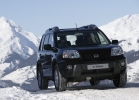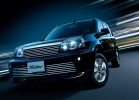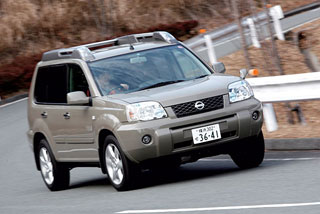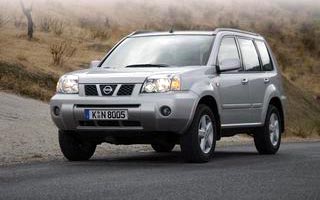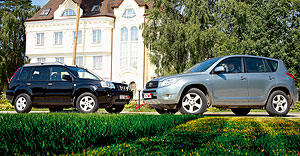Test drive Nissan X-Trail 2003-2007 SUV
Nissan X-Trail: Strokes to the portrait
The Nissan X-Trail is not at the market not so long ago: the Nissan SUV was debuted in 2001, that is, later his main competitors. But already now, at the beginning of 2004, the updated version of the X -Trail version enters the market - with a changed appearance, ennobled interior and a new turbodiesel engine.Three years, by the standards of the automobile business, is a relatively short time in order to subject the modernization car. This usually happens after four, or even in five years. And in the case of the X-ray about restyling, it was too early to think so far: the model was already sold with a bang. Apparently, the Nissanists wanted to immediately solve two problems: to present the public a new turbodiesel and at the same time update the model so as not to do this in a year and a half. Or maybe it will always be so now: as part of the company's development program, Nissan Marketers could easily provide for such frequent modernization of their models. After all, Nissan has been paying a lot of attention in recent years ...
What is the difference between a 2004 model year’s car? In our version - practically nothing. The shape of the front bumper and the false radiator lattice changed a little - that’s the whole facelifting. But if the sport version was on the test, then we could see another distinctive feature of updated machines - new rinings for the trunk on the roof, with fog lights integrated in them.
The X-traile profile has not changed, and the feed remained the same. With the exception of one insignificant detail - on the rear bumper now two round cataphos instead of the previous rectangular ones.
There are more changes inside. They worked thoroughly on the salon. The plastic of the panel has become better. But it is softer only visually, but actually as hard as in the prerestyled machine. The central console has changed. The dashboard remained in the center, but the console itself is now another, more convenient shape. Ventilation deflectors have a different design, but the main innovation is another climate control unit with rotating handles. The audio system became more convenient in operation and more expensive in appearance: instead of a clock, a radio with small buttons and aluminum decoration, normal music appeared in the same color scheme with a panel. Also, a very convenient remote control on the steering wheel appeared on restyled cars.
The front chairs with hypertrophied lateral support look great, but in fact it is not more convenient than in a prerestyled machine. The sidewalls are soft and do not provide lateral support. And the height adjustment, it seems to us, is completely inappropriate here - the seat, on the contrary, would like to lower below. By the way, in this version, the electric drive, as well as the front passenger, did not happen before. The sport version has a slightly different interior decoration, it has more aluminum, as well as stylish pedals.
The transmission on restyled cars remained the same, which is even good, because it is one of the best transmissions in the classroom. It not only provides the X-Trail drive for all wheels, but also allows the driver to choose one of their three modes, each of which is intended for various conditions of movement.
The first mode - 2WD - is designed to operate the car under ordinary conditions. The leading is only the front axle, and the entire torque is transmitted only to it - the rear wheels are not used. This allows you to save fuel, as well as improve the dynamics of acceleration on dry asphalt.
The second mode is also designed to operate the machine under ordinary conditions, but in this case the rear axle is automatically connected when the front wheels are slipped. This mode is convenient when moving along a slippery road or in the winter, when it is impossible to predict the coefficient of adhesion of the wheels with asphalt. The connection time of the second axis is minimal, and everything happens automatically, so that the driver does not even know what share of torque to which axis is transmitted to.
Well, the third mode of operation of the transmission - Lock - is intended only for movement in difficult conditions, when the car can stall. In this mode, the inter -esseed coupling, which connects the rear bridge, is rigidly blocked, and the torque is distributed between both axles. Hard locking allows more accurately predicting the behavior of the car on slippery soil, and also reduces the likelihood of slipping of one of the wheels, which very often leads to instillation of the car. In Lock mode, it is more convenient to ride in deep snow or dirt - uniform and constant distribution of torque through the axes allows you to increase cross -country ability. But as soon as you get out on the asphalt, you need to immediately go to the automatic mode or even turn on the front axle drive - you cannot use Lock mode on the usual coating. However, even if you forget to switch the transmission to another mode, the control electronics will do it itself.
Basin engines on restyled cars remained the same: in the basic version of the X-traile, it is equipped with a two-liter 140-horsepower engine, and the top version received a 2.5-liter four-cylinder engine with a capacity of 165 hp. For the deuce, only a five-speed mechanical transmission is proposed, and a 2.5-liter motor can be combined with both mechanics and a 4-speed automatic.
But the turbodiesel is now different, more powerful and burdened. With the previous working volume of 2.2 liters, it develops a capacity of 136 hp, and the torque indicator is increased to 314 nm at 2000 rpm. For comparison: before it was 114 hp. and 270 Nm at the same 2000 rpm.
Naturally, we were most interested in the turbodiesel - after all, with such a Nissan X -Trail engine, it is best sold in Europe. But in our republic it is a completely different matter, so there was a top version with an automatic transmission, a leather salon and a 2.5-liter gasoline engine on the test.
On a gasoline two-liter X-Reyle, we had never been going to ride, but version 2.5 was not impressed either. Acceleration is not as swift as you expect, and the noise from the engine is much. It turns out that this version with an automatic for dynamics is almost the same as a two -liter motor on the mechanics. Acceleration from a place to 100 km/h at X-Trail 2.5 AUT. It takes 11.1 seconds, and the deuce with a mechanical checkpoint has 11.3 seconds. By the way, a six -cylinder machine with a mechanical transmission is not much faster - 9.9 seconds. So our choice is the new 2.2-liter Common-Raleovsky turbodiesel with a capacity of 136 hp, which in dynamics is equal to a gasoline kopecks. And at maximum speed, thanks to a 6-speed checkpoint, which is offered only for a turbodiesel version, even exceeds a gasoline option by 3 km/h!
In addition to not very impressive acceleration dynamics, the 2.5-liter version was very surprised by the abundance of vibrations. At idle, the four -cylinder engine transfers vibration to the steering wheel: not fatal, but a little annoying. And when the automatic transmission stands on the drive, the vibrations begin to be transferred to the body, and even to the driver's seat. And it turns out that at the intersection, the 2.5-liter X-Trail trembles in the same way as a turbodiesel machine.
Automatic transmission, accessible only with this engine, was also not particularly impressed with its advantages. It is four -speed, the programs are very stretched, which negatively affects the dynamics, especially in transitional modes. Switching is sluggish, but hard, especially if you use a kik downs. But there is little use from it, because switching down is very stretched in time, and quick acceleration does not work. This automatic machine for quick maneuvers in the city is especially inconvenient: while the box will figure out while switching down, while the car accelerates, the window is already closed in the stream. But if you just go, without jerks and movements, then the Nissan X-Trail 2.5 AUT is felt quite comfortable and quiet. By the way, the manual regime, as well as the sports, is not provided here, so the driver in any case has to put up with the leisurely machine gun ...
Pavel Kozlovsky
A source: Autogazet / N 15 (454) dated 04.27.04
Test drives Nissan X-Trail 2003-2007
Nissan X -Trail 2003 - 2007
Nissan X-Trail malfunctions: Detailed information| X -Trail 2003 - 2007 | |
|---|---|
| Engine |  |
| Transmission |  |
| Control system and suspension |  |
| Brake system |  |
| Air heating and air conditioning |  |
| Launch and charging system |  |
| Electric components and so on |  |
| Corrosion body stability |  |

